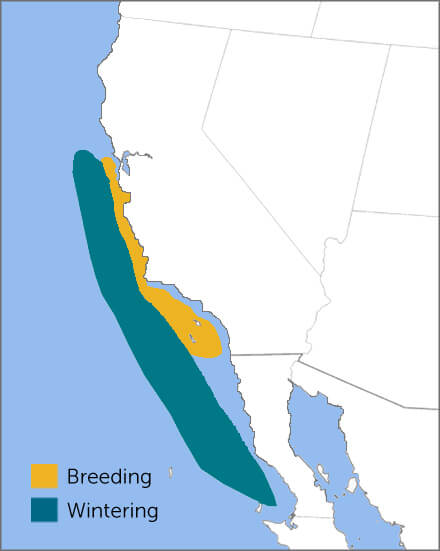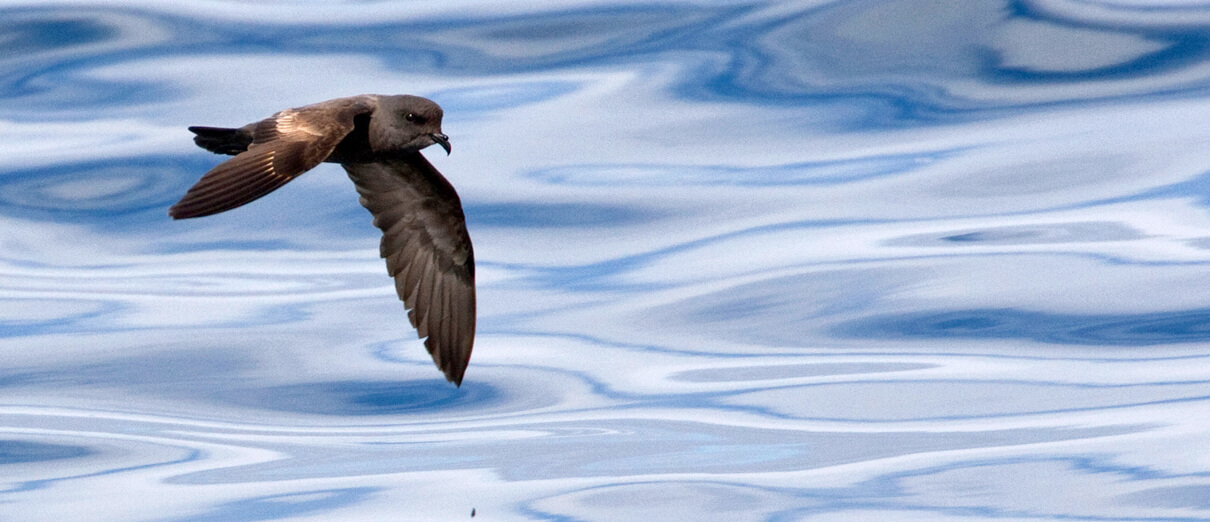
The Ashy Storm-Petrel's range is entirely within the California Current. Map by Cornell Lab of Ornithology.
The Ashy Storm-Petrel is a small, sooty-colored seabird, slightly larger than an Eastern Bluebird. An adult can fit nicely into the palm of one's hand and weighs just a bit more than one ounce. This specialized seabird can only be found in the area of the Pacific Ocean's California Current, where the cold waters are rich in nutrients that sustain sea creatures from tiny krill to enormous whales.
The species is a member of an order of seabirds (Procellariiformes) nicknamed “tubenoses” after the pair of horny tubes on their upper mandibles. These tubes have an important function: They channel and excrete excess salt, which is filtered out by specialized glands. These adaptations make it possible for the birds to ingest seawater — essential for a species at sea most of its life.
Sticking Close to Home
Unlike wide-ranging relatives such as the Band-rumped Storm-Petrel, the Ashy Storm-Petrel sticks close to home, never traveling far from its breeding colonies.
The Ashy Storm-Petrel breeds only from Cape Mendocino, California, to the northwestern coast of the Baja California Peninsula, Mexico, with the majority of birds nesting on California's South Farallon and Channel Islands. At its southernmost breeding sites on Mexico's Coronado and Todos Santos archipelagos, its population numbers fewer than 80 breeding pairs, and colony restoration is ongoing to enhance the number of breeding sites.
Although usually silent while at sea, the Ashy Storm-Petrel emits a soft rattling call while on its breeding grounds:
(Audio: Ashy Storm-Petrel by UCSC CCAL, XC77858. Accessible at www.xeno-canto.org/77858 )
Nesting by Night
Like the Black-capped Petrel, Newell's Shearwater, and many other seabirds, the Ashy Storm-Petrel comes to land only to breed, traveling to and from its colonies under the cover of night. It nests in burrows, but unlike some other storm-petrels, the Ashy Storm-Petrel does not dig its own. Instead, it uses existing rocky crevices and cavities on coastal cliffs as nest sites. The female lays a single egg deep in the burrow, and both parents take turns brooding the egg, then caring for the hatchling.
The Ashy Storm-Petrel takes its time nesting. Raising young from egg to fledging takes over four months — longer than other storm-petrels — and these birds don't begin breeding until they are four to six years old. Fortunately, though, this is a long-lived species, with banding records confirming individuals as old as 30 years.
As with many other seabirds, Ashy Storm-Petrel pairs reunite at breeding grounds for many years, usually nesting at the same burrow.

Ashy Storm-Petrel by Agami Photo Agency/Shutterstock
Meals by Float and Boat
Although many storm-petrel species feed by hovering above the ocean while pattering their feet on the surface, the Ashy Storm-Petrel takes a more leisurely approach. This bird prefers to dine while sitting atop the water, where it gleans larval fish and tiny crustaceans from the ocean surface. Feeding mostly at night, or at dawn or dusk, it often scavenges around fishing boats, sometimes gathering in large groups.
In the 1950s, the Ashy Storm-Petrel was greatly affected by organochlorines (DDT, DDE) released into waters throughout its range, which caused eggshell thinning. Today, a new threat has arisen: plastic pollution. This increasingly common pollutant in ocean waters is proving a significant threat to seabirds, which mistake floating plastic debris for prey. Ingested plastic accumulates in the birds' stomachs and can eventually starve them to death. In addition, as plastic breaks down in the ocean, it releases damaging chemicals that may attract, then poison seabirds.
Human Touch, Harmful and Helpful
The Ashy Storm-Petrel is listed as Endangered by the International Union for Conservation of Nature (IUCN). It faces threats similar to those of other island-nesting seabirds, including habitat loss and introduced species, especially predators such as rats and cats. On Southeast Farallon Island, Ashy Storm-Petrels face unusually high rates of predation by over-wintering Burrowing Owls, which are attracted to the island by high numbers of non-native House Mice.
Human activities near nesting areas create hazards, such as light pollution from vessels that disorients adults and newly fledged birds and leads to fatal collisions. The species is also vulnerable to wind turbines and other offshore development such as oil and gas extraction. In addition, climate change could impact the Ashy Storm-Petrel by warming the waters of the California Current, leading to a decline in nutrients and thus less food available for these birds.
ABC and Mexican partner Grupo de Ecología y Conservación de Islas, A.C. (GECI) are leading a project to restore and protect Ashy Storm-Petrel breeding sites in both the Coronado and Todos Santos Island groups along the Pacific coast of Mexico. We're using social attraction techniques, including acoustic playback systems, to lure the birds to artificial burrows. Monitoring this small population through nest-searches and banding, we hope to increase the number of pairs breeding here.
This effort is part of GECI's long-term seabird restoration program, which has been conducted on Mexico's northwestern Pacific Islands since 2013. In addition to the Ashy Storm-Petrel, this project will benefit the Critically Endangered Townsend's Shearwater, along with the Endangered Guadalupe Murrelet and Townsend's Storm-Petrel.
Donate to support ABC's conservation mission!



















































